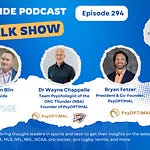This week we had the honor to interview Jake Lush McCrum, CEO of The Rajasthan Royals, a top Indian cricket team.
Show Notes: Through this interview, we touched on his background, and his role as a CEO of a top cricket team. Then we talked about how important are technologies to his organization, and which technology they use.
Best Quotes: Here’s some of the key discussion points and best quotes from our conversation with Jake:
On his background: “I think my route to becoming CEO has been a bit different to the classic route into sports. I studied economics at some universities in the UK and the US and I've always had a passion for sport, but when I came out of the university, I felt that the roles were all a little too specialized for me. So I wanted to do something broader. Hence, I went into the investment space, and started working for a FinTech company. Then I moved into the investment arm of Blenheim Chalcot, which is the tech venture builder which is run by Manoj Badale who is also the lead owner of the Rajasthan Royals. They own about 20 technology companies in FinTech, eds tech, music tech, and other sectors.
On how he ended up working for a top Indian Cricket team: “After working there, Manoj came up to me one evening in the office and said, "Jake, do you fancy going to India?" And I asked him for a little bit more information, but after getting the brief, I was quickly out to India, which was meant to be a five month project. I worked well with the chairman here out in India, Ranjit Barthakur. And then he basically pushed me over the next four years into all different areas of the business. Everything from the digital side, to merchandising, to sponsorship, to finance. And so I got a deep understanding of all elements, the challenges faced, and how to overcome them. And thankfully, I've progressed through the roles to become CEO now of Rajasthan Royals. Its been an exciting journey, we as a franchise have been at the forefront of most things. Whether that's a partnership with Niine Sanitary Napkins which is the first in sport, to really try and break that taboo around periods, to using new technologies like Oura Ring in cricket, or Catapult, or others. And actually seeing the material improvement that it has had on players year round is something that's really motivational for us.”
On which technologies his team uses today: “One, which is purely from a cricket batting perspective, is called Str8bat. So Str8bat technology basically creates a 3D image of the bat flow, and then it measures the impact speed, the impact location, the bat swing speed, and basically enables the coaches to make technical adjustments for players to show them the actual impact. As we know, with players, they need to see quantitative results immediately to make changes. And so Str8bat is really valuable for us because we can say, "Look, your bat was pointing two degrees more to the first second slip. You've now moved it further, and your impact speed has increased as a result." So that's one that we've used, and what we've done there is to link it through to fan engagement”.
On his team uses Str8bat to improve the fan experience: “We can figure out who has the highest impact speed. And then, where we have different activations, we bring Str8bat along and fans can try and compete and beat the players. So that's been a really effective tool for our coaches”.
On other technologies (Catapult, Oura..) that they use: “We use Catapult, which is huge in the world of sport and fitness, and it is really good for injury prevention. I think one of the interesting learnings, coming into cricket, is that players who are bowling specifically, are saying they're bowling at full intensity. And being able to just say, "Actually, no. You're at about 75% because we've got the data from you, in game and out game”, is really valuable for our sports science and physio teams. And then we are using the Oura Ring, which was used in the NBA in the bubble. Again, sleep is a crucial element in terms of performance. So tracking that, and giving the players an understanding of the importance of sleep so they can take time and care about it, is important. We brought that in this season and that's been really valuable to our guys, and it was honestly the most important thing they took with them out of the camp. They were all desperate to have their Oura Ring and show it off to everyone back home. So that was a big positive. We also use Right Eye where we try to improve reflexes and players’ vision. Lastly we use Greenfly, a content sharing platform that players really love. It allows players to extend the reach of our content. It has been very powerful as it allows players to make the content (images and videos) easily accessible to fans. It also helps them save time, and make them feel more positive about themselves. They have been a great partner for us as well”.
On the importance of properly implementing these technologies: “With all these technologies, I think the most important factor is implementation. It's all good having the best technologies in the world, but if you don't implement them effectively, you're not going to have any impact on performance. And you look at Amazon, and we talk about inputs, not outputs. And that's the crucial part here. It's great having these technologies, but unless you implement them effectively, you won't have the inputs working to drive the outputs on the field. And so that's something we've learned over the last few years, almost not to rush bringing in multiple new technologies, but when you bring something in, making sure everyone in the organization is brought into it, so the leaders in the performance side are brought into it. And that then helps the implementation through the rest of the squad, which has been really effective”.
On how important are technologies to its organization:” I've touched on it from a performance standpoint where they're obviously crucial as well from a business standpoint. So if I look at my other verticals in the business, the way we use technologies and different platforms to collaborate across teams, I think, is extremely valuable. We are all very reliant on Zoom and Google Meets, but project management tools, or content sharing tools can be extremely effective in improving efficiency and productivity. So again, the most important thing is implementation though. It's all good having the best tech, but If people don't buy into it, it's not going to bring you that benefit. So it's really important to think through that process, even before you've decided to align on getting the tech on board. The question is "How are you going to get players brought in?" It is important to get them brought in before you sign the partnership, or buy the software or the product, because then it just makes the flow a lot easier”.
On what he would like to build if he had unlimited engineering resources: “I think for us in cricket, the more elements that we can track in terms of a ball delivery and then the hitting of a ball, the better. I think in baseball, they've probably got about 20 more metrics than we track at the moment. So I think just from a realistic standpoint, I'd like to bring across all of those from baseball into cricket, because I believe that it would be hugely beneficial in terms of player tracking, valuing, et cetera. One interesting one from a more commercial fan engagement aspect, is that I would love to see heart rate sensors on players during games coming through on the broadcast. I think that I saw it in rugby (AFL). I think it was during a rugby league game three or four years ago. So it's not new though, but that would be interesting for us. It's immensely engaging. And I know players are sensitive around various elements, but I think for fans at home, just seeing the difference, would be great. Bowling the last ball of the match in our game recently this season, Kartik Tyagi had to defend four runs off the last over, which had a 0.1% probability of him achieving. And he did it, but seeing the difference in his heart rate versus the batsman, and seeing how that changes every ball would just be amazing for fans around the world”.
On his plan to build a sports performance center: “At the moment, we're trying to build a high performance center in our academy in Nagpur, in the middle of India. We want to bring different technologies that are out there and that we can bring from other sports, because we have a lot to learn. It is our number one priority”.
On VR and robotics projects they are working on: “We are working on a few different things with regards to robotics, and other elements that are really interesting. I think there are some cool things going on in VR as well. And transferring that across, and making it accessible for our players year round, wherever they are, and to continue to learn and develop, can be a really powerful tool. So there's a lot going on in sport. And we have to get our core tech working really well and effectively before we get too creative with things. Because as you've listed on this call, there are four or five things that we have not even looked into yet, but I'm really excited with what the future holds for technology in cricket”.
Upside Analysis: 🏏 Tech Cricket market
🔥Upside Chat: Alexi Pianosi, Strengths and Conditioning Coach, Pittsburgh Penguins (NHL)
🔥Upside Chat: Pierre Barrieu, High Performance Director, Toronto FC (MLS)
🔥Upside Chat: Len Zaichkowsky, World-Class’ Sports Biofeedback Expert
🔥 Upside Chat: David Hobbs, Mojo Vision (World's First AR contact lenses)











